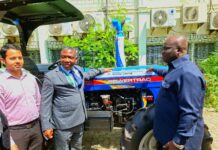Rwanda has 15 large commercial poultry farmers keeping between 20,000 and 100,000 layers each and 108 medium farms with between 5,000 and 20,000 layers.
That was revealed Thursday by Dr Solange Uwituze, Deputy Director-General of Animal Research and Technology Transfer at Rwanda Agricultural Board during the Poultry Africa 2019 – a major international exhibition and conference event for Sub-Saharan Africa.
In addition, the country has over 222 small commercial poultry farmers raising between 1,000 and 5,000 layers, Uwituze said adding that that is the category considered as the commercial farm.
For broilers, Uwituze said, there are 10 large commercial farms, 25 medium farms, and 20 small farms,
Poultry meat production increased from 13,700 tonnes in 2010 to 45,000 tonnes in 2018.
Less than a decade ago, Rwanda’s poultry sector was almost composed of smallholder farmers rearing dozens of chickens, which is considered like backyard chicken farming.
Uwituze indicated that Rwanda’s chicken population increased by 9 percent per year from 3.5 million in 2010 to 7.6 million in 2018.
“With this big jump in a sector that was rather considered as subsistence, we realise that it needed a lot of mobilisation from the bottom up,” she said.
“The vision of the poultry industry in Rwanda is to transform it from the subsistence farming dominated by the backyard farming into a decent job creator, and a decent livelihood endeavour for Rwandans,” she observed.
Uwituze said that Rwanda has a poultry investor who is already supplying poultry products to the UN forces.
“That means we can meet quality here in Rwanda, but now we want to take that quality to a larger scale and increase the number of investors of that level,” she said.
Andrew Butare, Chairperson of Rwanda Poultry Industry Association told Saturday Times that poultry was more of a subsistence activity without a determination from its practitioners.
“About five years ago, poultry farming was not given attention. People would do by just trying. But now, we have had companies or cooperatives that have made or are making poultry farming business. We are progressing,” he said.
Indeed, Uwituze said, the poultry industry was the fastest growing not only in Sub-Saharan Africa, but also in Rwanda, and this is mostly attributable to the growing number of the population as well as the proportion of people exiting rural settlement and coming to live in the city, therefore changing eating habits.
She said that the changing diets are in line with being aware of catering the nutritious choices they have, as well as the increasing income.
“This conference helps us learn from the practices of others who are more advanced in poultry farming so that a poultry farmer can rear about 5 million chickens without being worried that an epidemic might strike them, face lack of feed, or vaccines,” she said of the importance of the aforementioned Poultry Africa 2019.
Challenges that need to be tackled.
Challenges that are affecting poultry productivity in both Rwanda and Sub-Saharan Africa include expensive chicken feed, mainly as the poultry industry is competing very much with humans for the consumption of grains such as maize.
“We are actually striving towards looking at an alternative source of energy for the chicken industry,” she said.
Another challenge, she said, was the availability of pharmaceutical products: “Whereby we see actually the [poultry] industry booming here in Africa but are not catching up with the manufacturing of the pharmaceutical products.”








